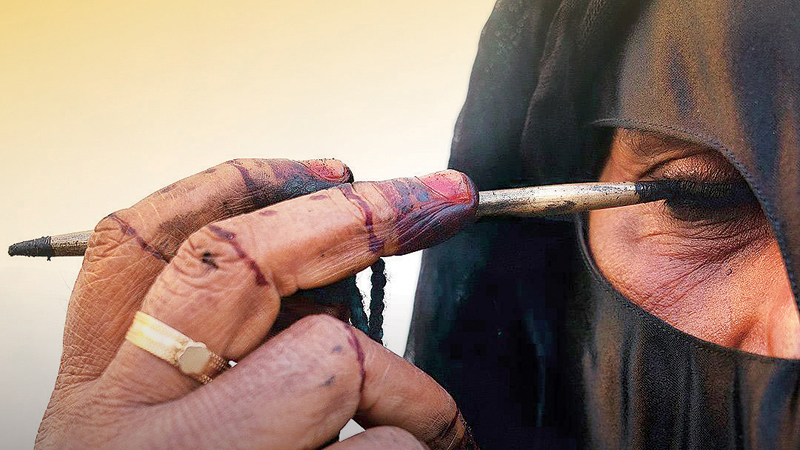

STORY BY MAZOUN AL GHALAINI
PHOTOS BY HAITHAM AL FARSI
Since ancient times, Omani women had been using traditional and locally produced kohl to beautify themselves. But the authentic black kohl used by the women in Masirah is even harder to make as they use shark liver to get the deep black that we’ve grown accustomed to seeing today.
Khashira al Sallawi is a local kohl maker from Masirah who learned this craft from her aunt.
“We used to watch our aunt when we were young from a distance and observe how she was making kohl. Even at that time, the process has been protected. She would usually tell us to get away so we don’t see how she makes it,” Khashira said.

“So I kept watching my aunt from a distance without her knowing. Eventually, I’ve observed the process and memorized her method,” she said.
When Khashira’s aunt passed away, there was no one else to take the spot she left behind. They used to buy kohl from local sellers but she didn’t like the ones found in the market and massed produced as they are not only hot but uncomfortable to the eyes.
It was then when she decided to follow in her aunt’s footstep and make kohl based on her process.
Khashira said that she has to ask her husband to bring the most important ingredient.
“I asked my husband to bring the shark fish. Recalling the process that my aunt used to do, I started coming up with my own version of kohl. The result was very satisfying, and the kohl was comfortable to the eye, then I started selling the kohl I make,” she said.
The kohl making process starts, when shark fish is caught and placed for two days in the storage room, safe from the exposure of the sun and dust, to brew the shark’s liver and take greater advantage of its benefits.
Two days later, the shark is chopped and the liver is extracted, cleaned and the bitter substance is discarded. In the next step, the liver is cooked on fire to melt and to extract oil out of it. Following this procedure, the extracted oil is filtered and impurities are removed.
The extracted oil, along with a piece of cotton is to be placed in a can and then burned. While the “oil and cotton” are burning, the can should be covered with a seashell and this is an important step to help the oil and cotton burn until they become ash. The smoke collected from this ‘burning process” produces the pure extracted kohl substance. The kohl is filtered in a separate container.
In the final step, the kohl is placed in a bowl of water to filter the impurities. The impurities are collected at the bottom of the bowl, and the clear pure kohl floats on the top of the water.
“Handmade kohl process ends in two methods: The dry way, extracting the pure dry kohl from water. That is how the kohl becomes powder. The second method is the watery way, mixing cow ghee or sheep ghee with water and kohl. Kneaded until a homogeneous mixture is formed, and then kohl is shaped into small balls ready for use,” Khashira said.
She also said that “Through these two methods, three types of kohl are formed. The first type is the dry kohl “powder kohl”. The second type is the watery kohl with cotton: the kohl balls are wrapped with a piece of cotton to protect them from dust and dirt. The third type is the watery kohl without cotton is wrapped around, because some people prefer without cotton.”
“The kohl industry is one of the old and important industries that is practised by women in Masirah. The role of the Omani Women Association in Masirah revolves around marketing and encouraging these traditional industries to continue.
“I am also a regular customer of Khashira’s kohl and all my family use it. It is unique and of good quality,” said Jokha al Araimi, chairperson of the Heritage Committee in the Omani Women Association in Masirah.
While shark season happens between March and August, it’s still possible to make kohl in other months by preserving the liver of the shark and making sure they are in good conditions for kohl processing.
Oman Observer is now on the WhatsApp channel. Click here



